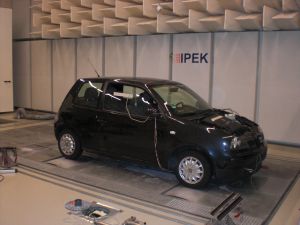Attempts to reduce CO2 emission and fuel consumption of combustion engines mainly focus on improvements inside the engine. Michael Hörig and Norman Nagel have now developed a process, by means of which emissions can be reduced without larger interventions in the engine. A patent has been applied for by the two students of mechanical engineering.
“If a combustion engine is operated in the overrun mode, i.e. in the mode in which no fuel is supplied and the engine is driven by the vehicle alone, cold air flows into the catalytic converter,“ Michael Hörig describes the problem. „For operation, however, the catalytic converter needs a temperature of about 300°C. Depending on the length of the overrun phase, this temperature is not reached and during subsequent normal operation, exhaust gas cleaning is worse for a certain time or does not take place at all.“ For this reason, Mi-chael Hörig and Norman Nagel have developed a system that collects the cold air upstream of the catalytic converter using a flap and feeds it back into the engine. The result: The operation temperature of the catalytic converter does not drop, it operates continuously, and emissions are reduced. “These overrun phases occur quite frequently during normal driving operation. Hence, our system will work quite often and total emissions will be reduced considerably,” says Norman Nagel.
The students performed measurements at the vehicle test rig of the Institute of Product Engineering (IPEK) and found that the emission reductions achieved even exceed those of similar systems. “Moreo-ver, our invention increases the efficiency of the catalytic converter, as we succeed in keeping the complete air flow away from the cata-lytic converter,” says Michael Hörig. Another big advantage compared to other developments lies in the comparably simple handling: The refeed system can be integrated easily in existing engine systems. Its installation by the automotive manufacturer is associated with low costs and low expenditure.
Both students of mechanical engineering had the idea to reduce emission about one year ago during a lecture. By and by, they de-veloped their idea further on their own initiative: From first principle sketches on a sheet of paper to the assembly of a test vehicle at their garage at home. “When we needed the support of KIT for our measurements, we met with the immediate approval of Professor Ulrich Spicher, Head of the Institut für Kolbenmaschinen (IFKM) and the staff of IPEK,” says Hörig. For several weeks, test series were performed on the KIT Campus for Innovation and Mobility, the area of the former Mackensen barracks. “KIT scientists and representatives of industry were highly interested in our positive measurement re-sults.” The young engineers now plan to enhance this interest. Within the next six months, they will make additional measurements to ex-plore the potential of their invention. Michael Hörig and Norman Nagel will present their ideas at international conferences. They have already established contacts to the big automotive manufacturers and wish to develop their system to maturity.
The Mobility Systems Center pools KIT activities relating to vehicle technology. Presently, 40 institutes with about 800 em-ployees on KIT Campus North and Campus South are working on methodological and technical fundamentals for tomorrow’s vehicles. It is their objective to develop energy-efficient, low-emission, and safe vehicles and mobility concepts. Research also covers the complex interactions of vehicle, driver, traffic, and society.
Under the heading of “Future Mobility”, KIT will present its sci-entific activities on its new “Campus East – Mobility and Innovation” during an Open Day on July 02. More information can be found at: www.pkm.kit.edu/3072.php
In close partnership with society, KIT develops solutions for urgent challenges – from climate change, energy transition and sustainable use of natural resources to artificial intelligence, sovereignty and an aging population. As The University in the Helmholtz Association, KIT unites scientific excellence from insight to application-driven research under one roof – and is thus in a unique position to drive this transformation. As a University of Excellence, KIT offers its more than 10,000 employees and 22,800 students outstanding opportunities to shape a sustainable and resilient future. KIT – Science for Impact.

